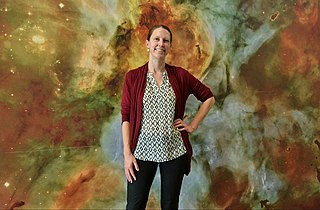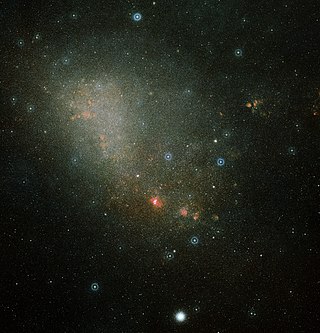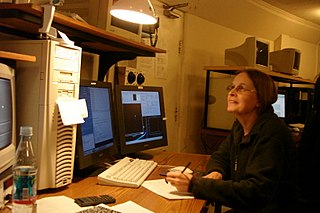A Thorne–Żytkow object, also known as a hybrid star, is a conjectured type of star wherein a red giant or red supergiant contains a neutron star at its core, formed from the collision of the giant with the neutron star. Such objects were hypothesized by Kip Thorne and Anna Żytkow in 1977. In 2014, it was discovered that the star HV 2112, located in the Small Magellanic Cloud (SMC), was a strong candidate. Another possible candidate is the star HV 11417, also located in the SMC.
Solar radius is a unit of distance used to express the size of stars in astronomy relative to the Sun. The solar radius is usually defined as the radius to the layer in the Sun's photosphere where the optical depth equals 2/3:
Amy J. Barger is an American astronomer and Henrietta Leavitt Professor of Astronomy at the University of Wisconsin–Madison. She is considered a pioneer in combining data from multiple telescopes to monitor multiple wavelengths and in discovering distant galaxies and supermassive black holes, which are outside of the visible spectrum. Barger is an active member of the International Astronomical Union.
KW Sagittarii is a red supergiant, located approximately 1,900 parsecs away from the Sun in the direction of the constellation Sagittarius. It is one of the largest-known stars. If placed at the center of the Solar System, the star's surface would engulf Mars.
Rosemary F. G. Wyse is a Scottish astrophysicist, Fellow of the Royal Astronomical Society (FRAS), and Alumni Centennial Professor of Physics and Astronomy at Johns Hopkins University.
Anna N. Żytkow is a Polish astrophysicist working at the Institute of Astronomy of the University of Cambridge. Żytkow and Kip Thorne proposed a model for what is called the Thorne–Żytkow object, which is a star within another star. Żytkow in 2014 was part of the team led by Emily M. Levesque which discovered the first candidate for such an object.

HV 2112 is a cool luminous variable star in the Small Magellanic Cloud. Until 2018, it was considered to be the most likely candidate for a Thorne–Żytkow object, but it is now thought to be an asymptotic giant branch star.
Laura A. Lopez is an associate professor of astronomy at Ohio State University studying the life cycle of stars. She was awarded the Annie Jump Cannon Award in Astronomy in 2016, which is awarded by the American Astronomical Society (AAS) for outstanding research and promise for future research by a postdoctoral woman researcher.

Heather A. Knutson is an astrophysicist and professor of planetary science at California Institute of Technology in the Division of Geological and Planetary Sciences. Her research is focused on the study of exoplanets, their composition and formation.
Jenny Greene is an Astrophysicist and Professor of Astrophysical Sciences at Princeton University. She is notable for her work on supermassive black holes and the galaxies in which they reside. Her work also involves a partnership with the Princeton Gravity Initiative and as co-founder and academic advisor to the Prison Teaching Initiative (PTI) at Princeton University.

HV 11423 is a red supergiant star in the Small Magellanic Cloud. It is about 200,000 light-years away towards the constellation of Tucana.

SMC 018136, also known as PMMR 37, is a red supergiant star located in the Small Magellanic Cloud. It is one of the largest stars and one of the most luminous SMC cool supergiants so far discovered, with a radius of 945 times that of the sun and a bolometric luminosity almost 200,000 times more than Sun. If it were in the place of the Sun, its photosphere would at least engulf the orbit of Mars.
Jessica K. Werk is an American astronomer and an associate professor in the Department of Astronomy at the University of Washington. Her work includes the study of intergalactic and interstellar media. Werk was a Hubble fellow at the University of California, Santa Cruz from 2013 to 2016, and won the $65,000 Sloan Fellowship in 2018. Her research focuses on the role of gas in the formation and evolution of galaxies and the intergalactic medium, primarily through spectroscopic observations in the optical and ultraviolet.
Blakesley Burkhart is an astrophysicist. She is the winner of the 2017 Robert J. Trumpler Award awarded by the Astronomical Society of the Pacific, which recognizes a Ph.D. thesis that is "particularly significant to astronomy." She also is the winner of the 2019 Annie Jump Cannon Award in Astronomy and the 2022 winner of The American Physical Society's Maria Goeppert-Mayer Award. The awards both cited her work on magnetohydrodynamic turbulence, and for developing innovative techniques for comparing observable astronomical phenomena with theoretical models.

Nidia Irene Morrell is an Argentine astronomer who is a permanent staff member at the Las Campanas Observatory in La Serena, Chile. She was a member of the Massive Stars research group led by Virpi Niemelä and the Hubble Heritage Project. Professionally, she is known for her numerous contributions related to the astrophysics of massive stars. She participates in the systematic search for variations of brightness in stellar objects, including the observation of a candidate for the Thorne–Żytkow object. She was also a member of the team that discovered the supernova ASASSN-15lh.
James E. Owen is an astrophysicist at Imperial College London who studies exoplanets and accretion disks.

Jane Rebecca Rigby is an American astrophysicist who works at the Goddard Space Flight Center and is Senior Project Scientist of the James Webb Space Telescope. She was selected one of Nature's 10 Ones to Watch in 2021 and Shape 2022. In 2024 she was awarded the Presidental Medal of Freedom by President Joe Biden.





